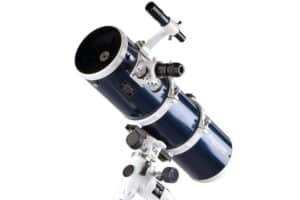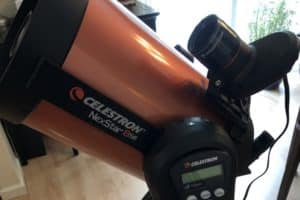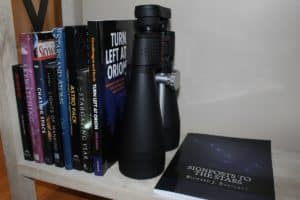Taking beautiful images of the stars, planets, and other celestial sights is known as astrophotography, and it’s an increasingly popular activity. Plus – thanks to advances in telescope optics, mounts with automatic tracking capability, and imaging technology – professional-grade astrophotography has become more affordable and accessible to the general public. In this article we’ll share with you our top 10 recommendations for the best telescope for astrophotography, with a solid line-up of options to suit your budget and level of experience.
See also:
Introduction: Best Telescope for Astrophotography
It can be an incredibly rewarding experience to capture breathtaking images of our universe far beyond what’s possible with a camera alone. Whether you’re a general photographer looking to branch out into astrophotography, or whether you’re an astronomy enthusiast looking to learn how to take stunning photographs of the sights you already know and love – astrophotography is an art form unto itself, and it takes some time and experience, plus the right equipment.
Choosing a Mount
The most basic decision you’ll make is whether you’ll be taking long-exposure photographs. The best images of distant objects can require hours of total exposure (taken in a series of “stacked” images). If you’re planning to take long-exposure images, you’ll need a mount designed to automatically track your target across the sky.
In fact, many would say that choosing the right mount for astrophotography is more important than choosing the right telescope. A great astrophotography mount, combined with an average DSLR camera (even without a telescope), can take fantastic images of the Milky Way and even deep sky objects. On the other hand, even the best telescope will produce subpar images with an unsuitable mount for tracking.
Wider and Faster is Better
Common advice for beginners in astrophotography is to look for a shorter focal length telescope (which gives you a wider field of view) and a “fast” focal ratio (which increases image brightness for a given exposure time).
Why? First, the focal length of your telescope determines the width of your field of view. A shorter focal length will ensure that you can fit your target completely into your field of view. (This is important if you’re photographing some of the larger targets like the Orion Nebula or Andromeda Galaxy.) Additionally, a wider field of view is more forgiving of tiny imperfections in your mount’s tracking capability – so it provides more flexibility for the beginner astrophotographer. For deep space astrophotography, a focal length of 600-800mm or even below is ideal.
Second, the focal ratio – which determines how fast your telescope can collect light, and therefore how fast you can take exposures – is important for capturing the sharpest possible images (minimizing blur and star trails for any particular exposure). Lower focal ratios are much easier to work with, because they enable you to capture more “light per pixel” at a given exposure length and aperture size. For faint deep-sky objects, a focal ratio of f/6 or lower is best for astrophotography. (And keep in mind that you can use a focal reducer to improve the focal ratio.)
Quick Summary of Our Guide
Part One – Astrograph Telescopes (click here to skip forward). If you’re looking for the best possible image quality, we recommend you invest in a telescope that’s considered an astrograph telescope. (Plus you’ll need to buy a separate computerized mount.) But be warned – astrograph telescopes can be relatively expensive.
Part Two – Beginner Astrophotography Options (click here to skip forward). If you’re looking to buy a general beginner telescope for stargazing, but you also want to do some very basic (short-exposure) astrophotography, this section is for you.
Top 10 Telescopes for Astrophotography in 2022 | Part One – Astrograph Telescopes
1. Orion 9534 ED80T CF Triplet Apochromatic Refractor Telescope
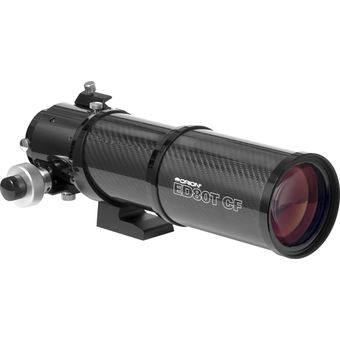
Image Credit: Orion (Used with Permission)
Premium triplet APO with high-quality optics. This triplet 80mm apochromatic (APO) refractor from Orion is our top choice for getting started with long-exposure astrophotography. (And one of our favorite Orion telescopes.)
If you’re not familiar with the terminology, a “triplet” is an objective lens composed of 3 glass elements, precision-matched together to minimize light dispersion. A triplet APO will provide sharper and more true-to-color images than a doublet APO (and both are better than an achromatic lens which is more typical of beginner refractor telescopes).
Scorecard – Orion 9534 ED80T CF Triplet Apochromatic Refractor
| Category | Our Verdict | Why? |
|---|---|---|
| Skill Level | Intermediate | For intermediate to advanced users |
| Quality | 5 out of 5 | Superb quality |
| Ease of Use | 4 out of 5 | Easy and fast setup, sturdy focuser |
| Power & Clarity | 5 out of 5 | Triplet APO for high quality optics |
| Control | 4 out of 5 | Precise focusing (Note: Mount is purchased separately |
| Portability | 5 out of 5 | Light-weight tube (5.5 lbs.) and foam-lined hard case |
| Accessories | 2 out of 5 | No eyepieces; mount purchased separately |
| Overall Value | 4 out of 5 | Great value |
Why We Like It
This telescope is designed for astrophotography first and foremost. (It doesn’t even come with eyepieces or diagonals for visual astronomy or terrestrial viewing – If you want those, you’ll need to purchase separately.)
The triplet apochromatic lens is made with FPL-53 extra-low dispersion (ED) glass, for amazing optical quality. The performance in astrophotography is superb – with a fast f/6 focal ratio and 480mm focal length.
The components are high-quality, with a sturdy dual-speed (11:1) 2″ Crayford focuser which is well-built and can handle the weight hanging off of it. Don’t expect a lot of bells and whistles here, though – you’re paying for the lens, not the accessories. Besides the tube itself, it comes with a 2″-to-1.25″ stepdown adapter, a dovetail finder scope base, Orion’s astronomy software – plus a nice foam-lined hard carrying case.
A couple other nice things about this telescope: It includes a “dew shield” which helps keep the lens clear for long-exposure sessions. It’s also good for terrestrial viewing if you add a 45-degree mirror diagonal.
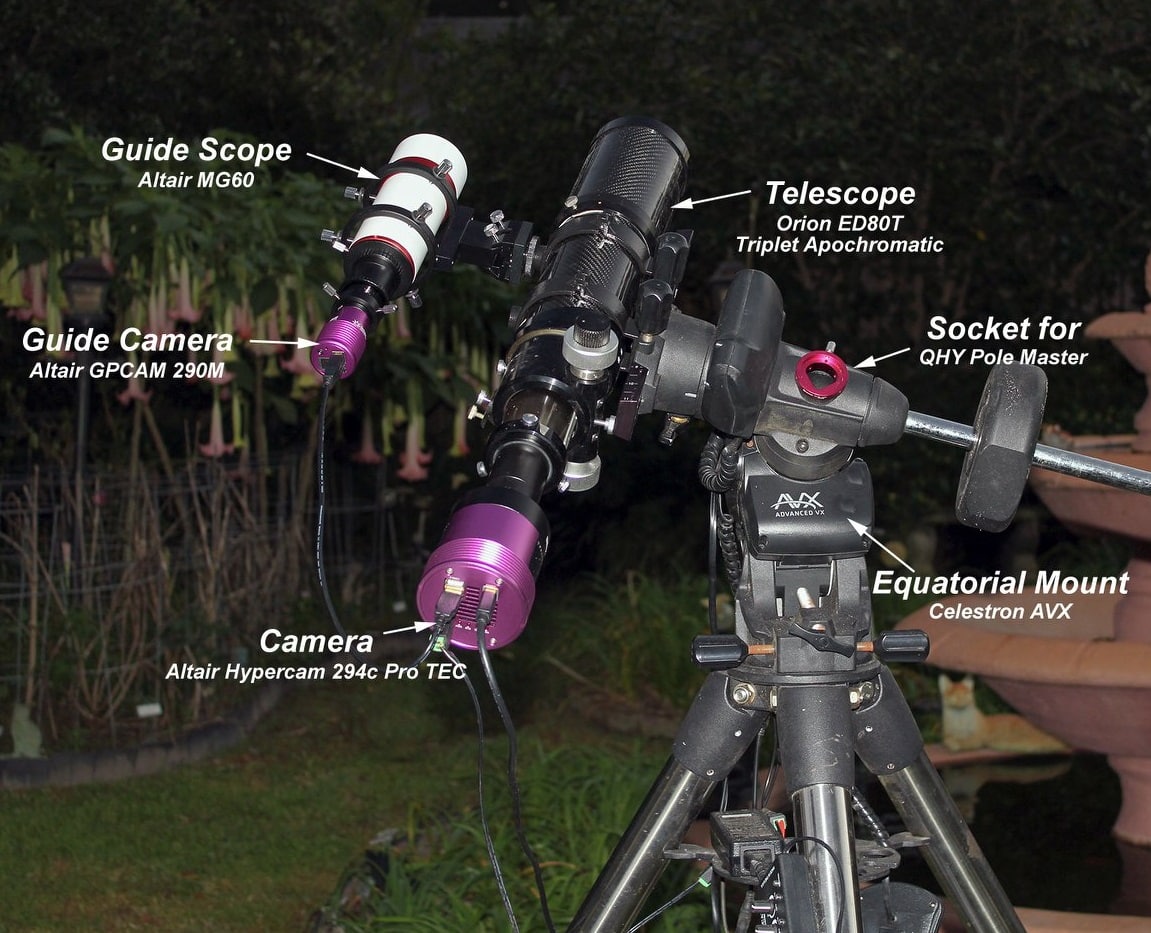
Here’s what the Orion ED80T looks like with a fully configured rig for astrophotography (shown here paired with Celestron’s Advanced VX mount); Image thanks to Patrick Prokop (used with permission)
Pros
- Great value APO triplet
- Premium optics – triplet with FPL-53 is an amazing APO lens for astrophotography
- Good aperture, focal length, and focal ratio (fast, and wide field of view) for astrophotography
- Sturdy construction, good focuser
- Built-in dew shield
Cons
- More expensive than the doublet APO’s for same aperture size
- Not for high magnification (160x theoretical limit) – this telescope is best for wide field and stacking long-exposure images
- As with all APO’s on this page, the mount and tripod are sold separately
- No eyepieces or diagonals included for visual usage (can be purchased separately)
- Only 1 year limited warranty from Orion
Recommended Accessories
Click here to expand- For long-exposure astrophotography, we recommend an equatorial mount with automatic tracking and the right amount of weight capacity for this telescope. Orion’s Atlas EQ-G is a great option for the ED80T: See it on Telescope.com
- Orion 8893 field flattener: See it on Amazon.com (Note: Because it’s already a fast focal ratio, you don’t really need a focal reducer or a combination flattener/reducer for the ED80T. However, a flattener is still helpful.)
- If you buy the Orion 8893 flattener, note that it will work with either M42 or M48 threads (your choice). If you’re using a Nikon or Canon DSLR, you can use a standard M42 T-ring for your Nikon camera (See it on Amazon.com) or Canon camera (See it on Amazon.com).
- If dew becomes a problem for your astrophotography sessions, you may need to invest in a dew control system. Orion sells a good 4-channel controller here: See it on Amazon.com
2. Sky-Watcher EvoStar 80mm APO Doublet Refractor Telescope
A “doublet” 80mm apochromatic (APO) refractor option for affordable astrophotography. The Sky-Watcher EvoStar 80mm APO offers an excellent (and affordable) APO astrophotography refractor. It produces images that are bright, sharp, and true to color.
In short, it provides stunning image quality for astrophotography, at an affordable price – so it makes a great “first APO” for anyone getting started. Its 80mm apochromatic objective lens employs high-quality, extra-low dispersion glass with proprietary coatings – allowing accurate color and astonishingly clear images.
The EvoStar 80mm APO refracting telescope offers excellent image quality with a number of advanced optical features. Whether you’re new to astrophotography or a seasoned pro, this telescope provides professional-level deep-sky imaging experiences.
Scorecard – Sky-Watcher EvoStar 80mm APO
| Category | Our Verdict | Why? |
|---|---|---|
| Skill Level | Beginner to Intermediate | For beginner to intermediate users |
| Quality | 5 out of 5 | Superb quality |
| Ease of Use | 4 out of 5 | Easy and fast setup |
| Power & Clarity | 5 out of 5 | Bright & clear, no false color |
| Control | 4 out of 5 | Precise focusing (Note: Mount is purchased separately |
| Portability | 5 out of 5 | Light-weight tube (7.3 lbs.) and foam-lined hard case |
| Accessories | 4 out of 5 | High-quality accessories (Note: Mount is purchased separately) |
| Overall Value | 5 out of 5 | Great value |
Why We Like It
First, the 80mm objective lens is large enough to gather plenty of light for astrophotography. It’s a modestly wide-field telescope and as such it offers great flexibility and power for astrophotography. With a 600mm focal length and a focal ratio of f/7.5, it’s easy to use and will perfectly frame some of the larger nebulae and galaxies.
Second, the EvoStar employs an apochromatic “matched doublet” lens employing sophisticated (and proprietary) lens matching technology and coatings to deliver an image that virtually eliminates chromatic aberration – delivering crisp, sharp, and true-to-color images. Combined with its 80mm aperture, the optical performance of the EvoStar’s objective lens is incredible, and provides beautiful, high-definition images that are perfect for astrophotography. (Note: If you have a higher budget, you might consider the 100mm or 120mm version of this same telescope. These are less flexible but will provide higher resolution for smaller or more distant celestial objects. Also, if you’re really on a tight budget, check out the Sky-Watcher 72mm elsewhere in this article.)
Beyond the optical performance, the quality of this telescope is apparent in every detail. For example, the focuser is a 10:1 dual-speed Crayford-style focuser, which makes it super easy and fast to achieve perfect focus after you’ve sighted your target. The telescope is made from high-quality, durable materials, with a metallic finish that feels great to the touch. Also, it comes with high-quality essential accessories, including a 8×50 Right Angle Correct Image (RACI) Finder Scope, 2” dielectric diagonal, 1.25” Adapter, and two LET eyepieces (5mm and 20mm). Mounting rings and a V-style dovetail are also included.
Pros
- Doublet image quality is superb – ideal for astrophotography
- Super light-weight at 7.3 lbs. and includes a hard case with foam lining
- Dual-speed focuser
- Powerful magnification (30x to 120x) with the included eyepieces
- 2 year limited warranty
Cons
- Expensive compared to reflector-style telescopes and lower-quality refractors
- Mount and tripod purchased separately
Recommended Accessories
Click here to expand- Sky-Watcher HEQ5: See it on Amazon.com
- We recommend the Sky-Watcher S20200 field flattener + focal reducer for the EvoStar 80ED. (The flattener ensures the edges of the image frame are not distorted, and the reducer is helpful for shortening the focal length which also reduces the focal ratio.) The Sky-Watcher S20200 reducer/flattener 0.85x can be found here: See it on Amazon.com
- If you buy the Sky-Watcher field flattener/reducer, note that it uses M48 threads (not standard M42 threads). So, if you’re using a Nikon or Canon DSLR, you’ll need a M48 T-ring for your Nikon camera (See it on Amazon.com) or your Canon camera (See it on Amazon.com).
- Orion dew control system: See it on Amazon.com
3. Orion 8-Inch f/4 Newtonian Astrograph Reflector Telescope [NEW MODEL]
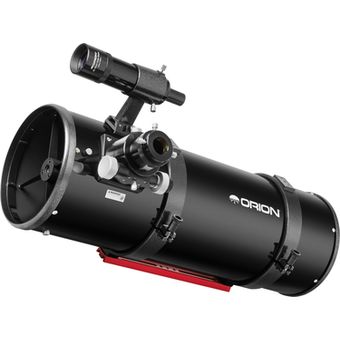
Image Credit: Orion (Used with Permission)
Here’s a reflector-based Astrograph option from Orion – provides excellent image quality at a more affordable price point than a comparable APO refractor. The views / images are fantastic. This Orion 8″ reflector offers a very large aperture at 200mm (7.9″), with an f/4 focal ratio (which is perfect for astrophotography). Its mirrors are made with high-quality BK7 glass, and have high-reflectivity (>92%) enhanced aluminum coatings.
Orion has also included a sturdy 2-inch dual-speed focuser, along with a cooling accelerator fan. All of this helps the Orion 8″ provide amazing, high contrast images, perfect for astrophotography, as well as breathtaking enjoyment for visual astronomy. The build quality is solid as well, and Orion offers great service as always.
Scorecard – Orion 8-Inch f/4 Newtonian Astrograph Reflector Telescope
| Category | Our Verdict | Why? |
|---|---|---|
| Skill Level | Intermediate to Advanced | Typical Newtonian issues; minimal accessories |
| Quality | 4 out of 5 | Great component quality |
| Ease of Use | 3 out of 5 | Collimation required; coma corrector needed for best flat-field performance |
| Power & Clarity | 4 out of 5 | Large aperture; great images |
| Control | 4 out of 5 | Dual speed focuser; mount will influence |
| Portability | 3 out of 5 | Less than ideal portability |
| Accessories | 2 out of 5 | Scope only |
| Overall Value | 4 out of 5 | High quality images and viewing experience |
Why We Like It
This Orion 8″ astrograph reflector excels for its visuals and in particular its astrophotography. The focal ratio and design allow for shorter exposure times due to the amount of light the scope can take in. The mirror placement and sizing also address common problems experienced by astrophotographers in getting light to DSLR sensors when using Newtonian reflectors.
Given the affordable price point, the trade-offs (you have to expect them) with the scope go to ease-of-use and accessories. Mounts and lenses come separately; and like with all Newtonians, you will likely want a collimation laser and coma corrector to go along with your purchase. (Orion’s website also recommends you purchase a coma corrector for optimal flat-field performance.)
In addition to the optical tube assembly and focuser, the telescope comes with a finderscope (8×50), a quick-collimation cap, cooling accelerator fan (12V DC), hinged tube rings, and a vixen-style dovetail mounting bar. (But no eyepieces included for visual astronomy, and of course no mount.)
Pros
- Better affordability compared to APO refractors for astrophotography
- Great Orion service
- High-quality, thoughtful design
- Also great for visual astronomy w/ large aperture and high-quality optics
Cons
- Mounts, eyepieces, collimation laser, and coma corrector all come separately
- Not ultra portable or beginner friendly
Recommended Accessories
Click here to expandYou’ll likely want to buy a computerized equatorial mount separately, collimation laser and coma corrector together with the telescope. Some recommended options include:
- Orion’s Atlas EQ-G: See it on Telescope.com
- Svbony Red Laser Collimator: See it on Amazon.com
4. Sky-Watcher EvoStar 72 APO Doublet Refractor for Astrophotography
Best APO option (in our opinion) if budget is your #1 priority. This is a great high-quality APO for getting started with astrophotography. If budget is a major priority for you (and keep in mind, you still need to buy a astrophotography mount and a few other accessories to complete your rig) – then this telescope is really a great option.
Arguably, the mount is more important than the telescope, and this 72mm doublet APO is a super smart way to stretch your dollar without sacrificing too much image quality.
Scorecard – Sky-Watcher EvoStar 72 APO Doublet Refractor
| Category | Our Verdict | Why? |
|---|---|---|
| Skill Level | Beginner to Intermediate | For beginner to intermediate users |
| Quality | 5 out of 5 | Superb quality |
| Ease of Use | 4 out of 5 | Easy and fast setup |
| Power & Clarity | 4 out of 5 | Bright & clear, no false color, but smaller aperture and not for high magnification |
| Control | 4 out of 5 | Precise focusing (Note: Mount is purchased separately |
| Portability | 5 out of 5 | Light-weight tube (4.3 lbs.) and foam-lined hard case |
| Accessories | 2 out of 5 | No eyepieces; mount purchased separately |
| Overall Value | 4 out of 5 | Great value |
Why We Like It
Like its grown-up siblings (the 80mm, 100mm, and 120mm Sky-Watcher EvoStar doublets) – this telescope shares the same high-quality optical performance with 2 proprietary matched elements in its objective lens, made with extra-low dispersion glass to provide super sharp, crisp, bright, and true-to-color images.
This 72mm version in particular is perfectly tuned for beginner astrophotography, with a wide field of view, short focal length (420mm), fast focal ratio (f/5.9), and a decent-sized aperture. Compared to an 80mm, you’ll need more and/or longer exposures to get the same image, but on a budget this is the telescope to beat.
Like some of the other small APO’s available on this page, this telescope is a “just the basics” optical tube assembly – so you need to be aware that you’re primarily paying for the lens, tube, and focuser (which is the same 10:1 dual-speed Crayford-style focuser found in the higher-priced siblings). Other accessories (even eyepieces, diagonals, etc.) are separately purchased.
Portability is fantastic with the telescope, as it includes (again, like its siblings) a foam-lined hard aluminum case. You’ll need to purchase a mount separately, but it comes with tube rings and a Vixen-style dovetail for mounting.
Pros
- Fantastic optical performance on a budget – targeted specifically for astrophotography
- Wide field of view, fast focal ratio, and short focal length – great for deep-sky imaging of Nebulae and more
- Two year limited warranty
Cons
- No eyepieces or diagonals included for visual usage (can be purchased separately)
- Not for high magnification (142x theoretical limit)
- Mount and tripod are sold separately
Recommended Accessories
Click here to expand- Sky-Watcher HEQ5: See it on Amazon.com
- Orion 8893 field flattener (compatible with the EvoStar 72ED): See it on Amazon.com
- If you buy the Orion 8893 flattener, note that it will work with either M42 or M48 threads (your choice). If you’re using a Nikon or Canon DSLR, you can use a standard M42 T-ring for your Nikon camera (See it on Amazon.com) or Canon camera (See it on Amazon.com).
- Orion dew control system: See it on Amazon.com
5. Explore Scientific ED80 Essential Edition – APO Triplet Refractor for Astrophotography
A super affordable triplet APO refractor that’s perfect for astrophotography. If you want a minimum 80mm, and you’re looking for an affordable triplet APO, this option is a great way to maximize value on your budget. The ED80 Essential Edition is a fantastic way to get ultra-sharp images with nearly perfect color accuracy. And the images produced by this triplet are truly amazing!
Scorecard – Explore Scientific ED80 Essential Edition
| Category | Our Verdict | Why? |
|---|---|---|
| Skill Level | Beginner to Intermediate | Great first astrograph telescope |
| Quality | 5 out of 5 | High-quality ED glass and a true triplet APO refractor |
| Ease of Use | 4 out of 5 | Excellent usability |
| Power & Clarity | 5 out of 5 | Triplet APO for high quality optics |
| Control | 4 out of 5 | Precise focusing (Note: Mount is purchased separately) |
| Portability | 4 out of 5 | Light-weight tube (5.95 lbs.) but does not come with a case |
| Accessories | 3 out of 5 | No eyepieces; but does include 2" diagonal and dovetail rings |
| Overall Value | 5 out of 5 | Superb overall value for a true triplet |
Why We Like It
Explore Scientific has a great reputation in the astrophotography community. And we highly recommend this option because the optical quality is truly stunning. It features an air-spaced triplet optical design which gives it nearly perfect performance in terms of minimizing chromatic aberration. As a result, it can create super sharp, clear, high-contrast images. According to Explore Scientific, this is achieved by “combining genuine HOYA extra-low dispersion (ED) glass and proprietary EMD enhanced multi-layer deposition coatings on all optical surfaces”.
The ED80 Essential Edition includes specs that are ideal for astrophotography. It gives you a decent-sized aperture (80mm) and a short focal distance (480mm) with f/6 focal ratio.
Pros
- A great first telescope for astrophotography
- An affordable way to get a true triplet APO refractor
- Fine-tuned for long-exposure imaging
- Light-weight and highly portable, easy to use
- Includes a 2″ diagonal and vixen dovetail rings
Cons
- Mount and tripod are sold separately
- Does not come with a case
- The guide scope mount is proprietary to Explore Scientific, so you may need separate rings for your guide scope
Recommended Accessories
Click here to expand- Sky-Watcher HEQ5: See it on Amazon.com
6. Explore Scientific Carbon Fiber ED102 f/7 APO Triplet with Hoya FCD100 Optics
Our pick for best high-end apochromatic (APO) telescope for astrophotography – if budget is no object. This is the “big brother” to the Explore Scientific ED80. With its air-spaced triplet lens and a large 102mm aperture, it delivers amazing optical performance. If you can afford to spend more for your APO telescope, this is the one you want to buy!
Scorecard – Explore Scientific Carbon Fiber ED102
| Category | Our Verdict | Why? |
|---|---|---|
| Skill Level | Intermediate | High-end option |
| Quality | 5 out of 5 | High-quality ED glass and a true triplet APO refractor |
| Ease of Use | 5 out of 5 | Excellent usability plus it's great for visual astronomy |
| Power & Clarity | 5 out of 5 | Triplet APO with 102mm aperture for stunning images |
| Control | 5 out of 5 | High-quality and sturdy focuser (Note: Mount is purchased separately) |
| Portability | 4 out of 5 | Light-weight carbon fiber tube (9.3 lbs. with cradle) but does not come with a case |
| Accessories | 3 out of 5 | No eyepieces; but does include 2" diagonal and dovetail rings |
| Overall Value | 4 out of 5 | Excellent overall high-end telescope |
Why We Like It
One really cool thing about this telescope is that it’s designed with carbon fiber (instead of metal which is heavier). This allows it to perform better on any mount – which allows for smoother and more precise imaging.
The HOYA FCD100 ED glass is considered to be one of the best glass types available for APO refractors. As a result, the ED102 features “unprecedented advanced chromatic aberration correction” according to Explore Scientific.
With a 102mm aperture, you can use this telescope for visual astronomy in addition to astrophotography. So it’s more versatile than a smaller telescope. We also like the integrated dew shield. The 714mm focal length gives you a f-ratio of f/7 – so it’s fast enough for astrophotography while also supporting good magnification for visual exploration of the sky.
Another nice feature: It comes with a new 2.5″ hexagonal 10:1 two-speed focuser which is specially designed to be extremely strong and sturdy. (You can load up to 10 lbs. on the focuser!)
Pros
- Super high quality optical performance
- Large 102mm aperture gives it versatility for astrophotography and visual astronomy
- Light-weight carbon fiber design
Cons
- Expensive
- Mount, tripod, case, and finder scope are all sold separately
Recommended Accessories
Click here to expand- Sky-Watcher HEQ5: See it on Amazon.com
Top 10 Telescopes for Astrophotography in 2022 | Part Two – Beginner Options
7. Celestron NexStar 6SE Computerized Telescope
Our pick for best general-purpose telescope with some good beginner astrophotography features. The NexStar 6SE is not considered a telescope for serious astrophotography – and you definitely shouldn’t be buying it with the expectation that you can take hours of long-exposure stacked images of distant nebulae and galaxies.
With that important disclaimer out of the way – the 6SE is a fantastic all-around telescope for gaining maximum possible enjoyment from astronomy, learning the skies, and even getting your feet wet with beginner astrophotography. It’s one of our favorite telescopes from Celestron.
Also, if you fall in love with astrophotography, the 6SE can “grow with you.” You can dismount this telescope and combine it with a computerized equatorial to start taking your astrophotography skills to the next level.
Telescopes from the NexStar SE family come in a range of sizes, from the 4SE (4″) up to the 8SE (8″). If your budget is higher, check out the flagship of the NexStar SE series – the NexStar 8SE (our review here). (Also, see our best telescopes under $1000 article for additional comparison points.)
Scorecard – Celestron NexStar 6SE Computerized Telescope
| Category | Our Verdict | Why? |
|---|---|---|
| Skill Level | Beginner to Intermediate | Advanced computerized capabilities make it easier to operate |
| Quality | 4 out of 5 | Great warranty; solid component quality; suitable for short-exposure astrophotography |
| Ease of Use | 5 out of 5 | Automatically locates and tracks objects |
| Power & Clarity | 4.5 out of 5 | Large 6" aperture; good magnification |
| Control | 4 out of 5 | Computerized AZ mount |
| Portability | 4 out of 5 | Light-weight and easy to move |
| Accessories | 3 out of 5 | Basics included but there are a few additional things you'll probably want to add |
| Overall Value | 4 out of 5 | Great value; great first telescope; great NexStar SE family of scopes |
Why We Like It
The Nexstar 6SE is an extremely popular computerized telescope. It provides excellent optical performance with a 6″ (150mm) primary mirror, and an easy-to-use computerized mount (i.e. it can automatically find and track 40,000 astronomical objects based on your location).
For astrophotography, the 6SE makes it easy to attach a camera so you can start taking images of the sky. (Your DSLR camera attaches with a separately purchased adapter.) You’ll be able to get wonderful photos of the detail on the moon, as well as planetary photography and other bright objects. It’s less ideal for deep-sky images of distant galaxies and nebulae – it has a long focal length and high focal ratio, so it will do best with bright objects and zoomed-in details.
If you do plan to try your hand at slightly longer exposures, or take a series of exposures as the telescope tracks across the sky, one interesting thing about the 6SE GoTo mount is that it can be manually polar-aligned using the built-in “wedge”. This is by no means a substitute for a true equatorial computerized mount – but it’s better than what you would get using the computerized Alt-Az tracking of the 6SE without being polar aligned. So, it’s a helpful feature for getting started in astrophotography – as long as you recognize its limitations as well.
The 6SE is fairly portable and easy to setup (a little heavy, but still fits easily in your car and can go with you on a camping trip) – and you get the basic accessories needed, including a red dot StarPointer finderscope, 25mm basic eyepiece, and 1.25″ star diagonal.
Pros
- User-friendly design, fully computerized “GoTo” capability
- Provides bright, detailed images with large aperture and high magnification capability
- Easy to assemble and align
- Capable of high magnification (the included 25mm eyepiece gives you 60x magnification, but you can go much higher with this telescope)
- 2 year Celestron warranty
Cons
- Not suitable for long-exposure astrophotography
- We wish it came with more eyepiece options for more flexibility
Recommended Accessories
Click here to expand- If you want to connect your DSLR camera (Canon or Nikon), Celestron sells the appropriate T-adapter and T-rings here: See it on Amazon.com
- Celestron carrying case for NexStar optical tubes: See it on Amazon.com
- NexYZ adapter if you want to take images with your smartphone: See it on Amazon.com
- PowerTank portable power supply: See it on Amazon.com
Using a “Piggyback” DSLR with the NexStar Series
While the NexStar computerized mount is not on par with a computerized equatorial mount for astrophotography, it’s possible to use it for a series of short-exposure shots. We came across a very interesting article by S. D. Falchetti, explaining how he attached a “piggyback” DSLR to the NexStar mount to take some extraordinary astrophotography images. Check out the article for the details.
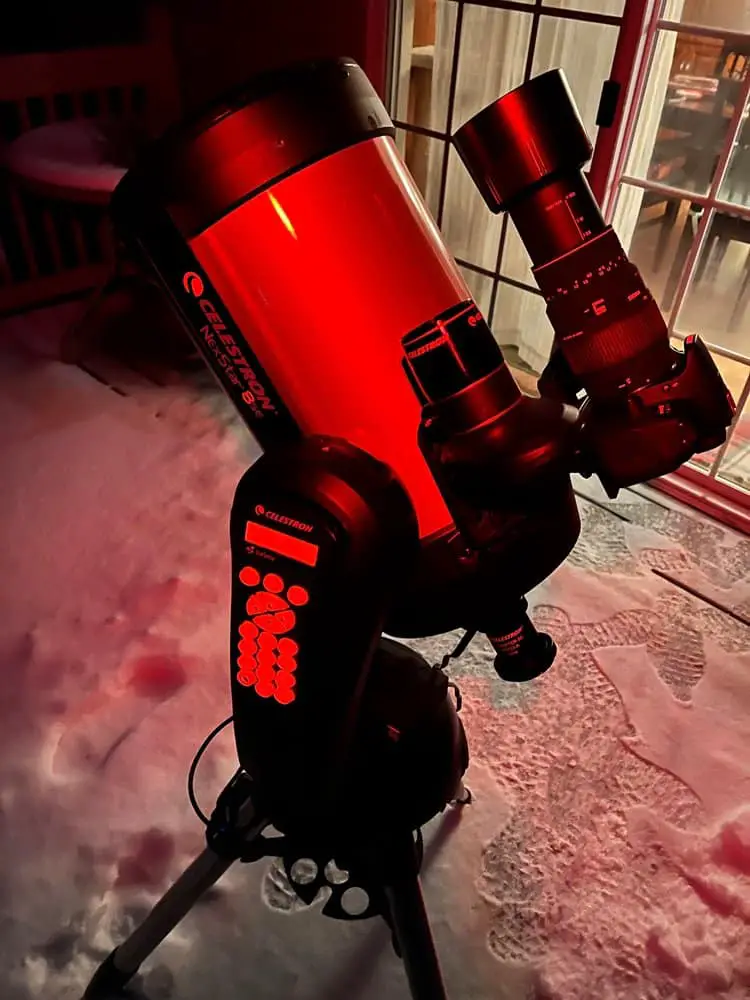
Image Credit: S. D. Falchetti (Used with Permission)
8. Celestron AstroMaster 130EQ-MD Newtonian Telescope
Good beginner Newtonian reflector with a motorized equatorial mount. The AstroMaster 130EQ-MD is the same as the AstroMaster 130EQ but it includes a motor drive for the German equatorial mount.
You will NOT be able to take super long exposure photographs with this setup, but you’ll have a much easier time taking numerous shorter exposures because of the motor drive. (Keep in mind – motorized is not the same as computerized! The tracking is not automated, and the speed is not perfectly tuned to the rotation of the earth. But it beats the heck out of manual tracking for extended photography sessions.) This is a good budget option for getting started with astrophotography. (For comparison, see here for our best telescope ideas under $300.)
Scorecard – Celestron AstroMaster 130EQ-MD Newtonian Telescope
| Category | Our Verdict | Why? |
|---|---|---|
| Skill Level | Beginner to Intermediate | Suitable for beginners but can grow with you |
| Quality | 4 out of 5 | Great component quality |
| Ease of Use | 3 out of 5 | Requires collimation |
| Power & Clarity | 4 out of 5 | Wide aperture for bright images |
| Control | 4 out of 5 | Smooth EQ controls plus motorized mount |
| Portability | 3 out of 5 | A little heavy, but still portable |
| Accessories | 4 out of 5 | Everything needed plus two eyepieces and a motor drive |
| Overall Value | 4 out of 5 | Great value |
Why We Like It
This is a pretty good setup for beginner astrophotography (at a low price point) for 2 main reasons.
First, the mount – it’s nowhere near as capable as true astrophotography mounts, but it’s a big step up from manual tracking when you’re just getting started with astrophotography. The motorized drive will do a decent job keeping your object in frame, so you can take lots of short-exposure shots. You can practice your skills starting with lunar and planetary photography. This telescope can “grow with you” as well – when you’re ready for a more sophisticated computerized mount.
Second, the 130mm aperture provides a lot of light – with a short focal length (650mm) and fast focal ratio (f/5) which is really ideal for minimizing your exposure time and limiting blurring / star trails. The 130mm is also fantastic for visual astronomy and will give you bright, clear images. The optics are high quality and we like the fact that this is a true Newtonian reflector (not a Bird-Jones style which is sometimes used on entry-level reflectors).
Accessories include two eyepieces (20mm and 10mm, for 33x and 65x magnification respectively), a travel tripod, motor drive, and a StarPointer red dot finderscope. Keep in mind, as a Newtonian reflector, its optical system will need collimation. It can be a tricky process for beginners, but you’ll be fine after you get the hang of it. Overall, the 130EQ, with its compact grab-n-go design, is a great choice for a beginner telescope that allows you to try out basic astrophotography.
Pros
- Great for visual astronomy and beginner astrophotography
- Large aperture and good focal length for taking short-exposure images
- Delivers sharp images
- Compact & portable (if not super lightweight at 28 lbs.)
- 2 year warranty from Celestron
Cons
- Until you develop the skill, it’s a bit tricky to setup (requires collimation)
- Not suitable for long exposure astrophotography
Recommended Accessories
Click here to expand- Celestron sells a nice upgrade kit specifically for this line of telescopes: See it on Amazon.com
- Smartphone adapter: See it on Amazon.com
9. Celestron Advanced VX 6″ Schmidt-Cassegrain Telescope
Starter telescope for beginner astrophotography that includes Celestron’s Advanced VX computerized equatorial mount. This is a good option if you’re looking for a mount + telescope in one package for beginner astrophotography. Celestron’s Advanced VX mount with 6″ Schmidt-Cassegrain (compound / catadioptric) telescope is suitable for long-exposure imaging while it also delivers a great experience for visual astronomy.
Scorecard – Celestron Advanced VX 6″ Schmidt-Cassegrain Telescope
| Category | Our Verdict | Why? |
|---|---|---|
| Skill Level | Beginner to Intermediate | Great option for beginner astrophotography |
| Quality | 4 out of 5 | Excellent overall quality |
| Ease of Use | 4 out of 5 | Great set of user-experience features with AVX mount |
| Power & Clarity | 4 out of 5 | Sharp imaging capability and 6" aperture |
| Control | 5 out of 5 | Computerized mount with autoguider port |
| Portability | 4 out of 5 | Telescope is compact and just 10 lbs. AVX mount is more portable than heavier options. |
| Accessories | 3 out of 5 | Just the basics and one 25mm eyepiece |
| Overall Value | 4 out of 5 | Excellent overall value |
Why We Like It
What’s great about this telescope from Celestron is that it includes two flagship components in one package. First, you get Celestron’s Advanced VX mount. It’s a fully computerized equatorial mount and includes an autoguider port for long-exposure imaging. The Advanced VX is still considered an entry-level mount for astrophotography, but it’s a huge step up from beginner telescope mounts. As long as your payload stays below 30 lbs., this mount provides a portable, light-weight option for high quality astro-imaging. (And that’s easy because the telescope tube only weighs 10 lbs. So you can still add a camera, autoguider, etc.)
Second, the telescope itself is a 6″ Schmidt-Cassegrain design which is a pretty good telescope for both imaging and visual astronomy. It’s compact and highly portable due to its compound design. The quality is excellent with StarBright XLT optical coatings. Further, image quality is crisp and sharp, and the Schmidt-Cassegrain design eliminates chromatic aberration.
You might notice the telescope advertises a focal ratio of f/10 – and that might seem at first like it’s too high for good imaging. However, you actually have 3 options: (1) You can use the f/10 ratio as-is. (2) You can add an optional focal reducer and get the ratio to f/6.3. And (3) you can use a 3rd party lens assembly to get a f/2 ratio.
Accessories are pretty basic. It comes with a 25mm eyepiece, 1.25” star diagonal and 6×30 finder scope.
Pros
- Great for visual astronomy and beginner astrophotography
- Delivers sharp images
- Compact & portable (if not super lightweight at 28 lbs.)
- 2 year warranty from Celestron
Cons
- Only one eyepiece included
Recommended Accessories
Click here to expand- Celestron focal reducer designed specifically for this telescope, gives you a f/6.3 ratio: See it on Amazon.com
- PowerTank portable power supply: See it on Amazon.com
- DSLR camera T-adapter and T-rings: See it on Amazon.com
- Celestron carrying case compatible with this optical tube assembly: See it on Amazon.com
10. Sky-Watcher Classic 150P Dobsonian 6-inch Aperture Telescope
Excellent overall beginner telescope, can also be used for single-shot, short-exposure astrophotography. Designed for ease-of-use and a large aperture, the Sky-Watcher Classic 150P is a great choice for beginners. Dobsonian telescopes are a great choice for any beginner looking for detailed, bright views with a plain, affordable design. You can attach a camera or smartphone and get great shots of the moon, Saturn, Jupiter, and other bright targets.
Scorecard – Sky-Watcher Classic 150P Dobsonian 6-inch Aperture Telescope
| Category | Our Verdict | Why? |
|---|---|---|
| Skill Level | Beginner | Suitable for beginners |
| Quality | 4 out of 5 | Great component quality |
| Ease of Use | 4 out of 5 | Requires collimation but overall ease of use is high |
| Power & Clarity | 4 out of 5 | Wide aperture for bright images |
| Control | 3 out of 5 | Easy to move but not as precise as EQ controls |
| Portability | 3 out of 5 | A little heavy, but still portable |
| Accessories | 3 out of 5 | Good set of starter accessories |
| Overall Value | 4 out of 5 | Great value |
Why We Like It
This 150mm (6″) telescope offers vivid, bright, detailed images, thanks to its large aperture. Equipped with borosilicate mirrors coated with titanium, silicon dioxide, and quartz, the two mirrors of the telescope provide 94% of reflectivity.
This is a great telescope for visual astronomy. It’s optimized for viewing both solar system and deep-sky objects including star clusters, nebulae, and galaxies. With two mirrors, a rocket box, and a metal tube, this telescope also comes with a luminary chart. The chart helps you discover celestial objects manually so you can learn how to navigate the sky and “star hop” to find what you’re looking for and improve your knowledge of the sky.
Pros
- Great beginner telescope overall for learning the night skies
- Impressive performance
- Sturdy & lightweight design
- Large aperture
Cons
- Manual tracking – so you won’t be taking multi-exposure sequences
- Not suitable for long-exposure astrophotography
Frequently Asked Questions (FAQ) – Best Telescope for Astrophotography
What is Deep-Sky Astrophotography?
Deep-sky (or deep-space) astrophotography involves capturing images of deep-space objects like nebulae and distant galaxies. Capturing beautiful images of these celestial objects requires significant skill and experience.
The process can be broken down into basically 3 steps:
- First, you capture a series of exposures as your rig (telescope, mount, etc.) automatically tracks the object across the sky.
- Second, you use software to “stack” these images to increase the signal-to-noise ratio.
- Third, you use software for final processing to bring out the true beauty of the images.
What Equipment Do I Need for Astrophotography?
A typical astrophotography setup involves the following:
- Computerized equatorial mount
- The main telescope (an astrograph telescope) – typically an APO refractor, but reflectors can also work – often with a short focal length and fast focal ratio
- Tracking telescope / finder – attached to a computer for precision tracking
- Accessories as needed for astrophotography: focal reducer and/or field flattener, camera adapter, and filters
- A camera – either a DSLR or a dedicated CCD camera for astronomy
- Software for stacking the images (e.g. DeepSkyStacker or similar)
- Software for post-processing (e.g. Adobe Photoshop or similar)
If you’re not ready to invest in all that equipment, one option to consider is trying astrophotography using remote telescopes. You can capture images using these world-class remote telescopes situated in dark-sky locations around the world. Then you can learn how to process the data and experiment with various approaches before buying your own equipment.
Is the Aperture Important for Astrophotography?
A larger aperture collects more light, and this is super important for visual astronomy (looking with the human eye through the telescope’s eyepiece). However, for astrophotography, the size of the aperture is not the most important factor in overall imaging quality. You can take amazing astrophotography images with an APO refractor of 80mm or even smaller.
Other factors are arguably equally or even more important, including the following:
- Quality of your mount
- Precision of your computer-enabled tracking
- Ability to maintain accurate focus (some rigs utilize computer-assisted automatic focusing)
- Fast focal ratio to help minimize exposure time
- Choosing the right camera, settings, number and length of exposures, flattener/reducer, filter(s)
- Image stacking and post-processing
With that said – all other things being equal, a large aperture is still desirable for astrophotography because it reduces your focal ratio. (Remember: The focal ratio equals your focal length divided by your aperture size. So, a large aperture collects more light for any given focal distance.) If you’re on a tight budget, you should put your money into your mount. But on a higher budget, a stronger mount with a larger telescope lens (all else equal) will produce superior results.
What is the Best Telescope for Getting Started With Astrophotography?
It really depends on your budget and how soon you plan to get into long-exposure shots with a computerized mount.
Short-exposure astrophotography
If you’re on a tight budget OR you want a general-purpose astronomy telescope that can also do a little bit of astrophotography, we recommend you pick out one of the beginner options in this article.
These telescopes are (first and foremost) designed for visual astronomy (not for astrophotography). However, some of them have convenient options for attaching a smartphone or a DSLR so you can get started with short-exposure astrophotography. (Don’t even try taking a long exposure with any of these options! But still, you’ll be able to take beautiful images of the moon and planets, and you’ll be able to take multiple short-duration shots and “stack” them later using software.)
A few of these options are wide-aperture reflector style telescopes that can also “grow up” to become full-fledged astrophotography telescopes when you (later) decide to purchase a more sophisticated computerized equatorial mount. This will allow you to have a great telescope for visual astronomy, dabble in astrophotography, and then later add more equipment to start doing more serious deep-sky astrophotography.
Long-exposure astrophotography
On a mid-range budget, we recommend you consider an APO doublet or triplet refractor around 80mm. On a larger budget, we recommend you go for the best triplet APO you can afford (with a focal ratio appropriate for astrophotography).
Astrograph telescopes have specs that make them suitable for long-exposure astrophotography, typically with a short focal length and a low focal ratio. Sometimes they include built-in field flatteners and other features that help optimize imaging capability. These are usually apochromatic (APO) refractors, but you’ll see astrograph telescopes of both major types (reflectors and refractors).
In our opinion, the best type of telescope for crisp, true-to-color, user-friendly, high-contrast astrophotography is a refracting telescope with an apochromatic (APO) objective lens. (It’s also the most expensive, for any given aperture size.)
If you need to stretch your dollar a little further, you can potentially save a little bit by going with an astrograph reflector. (There are several types of reflector telescopes that can be optimized for astrophotography, including Newtonian reflectors, Maksutov-Cassegrain telescopes, Schmidt-Cassegrain telescopes, and others.) But make sure you’re willing to deal with the extra hassle of collimation.
Finally, you’ll almost always need to purchase a computerized equatorial mount separately.
What Equipment Do I Need for Landscape or Milky Way Astrophotography?
If you’re interested in taking photos of landscapes with the night sky as the backdrop, you really don’t need a telescope. (The telescopes we cover in this article are for deep-sky and planetary astrophotography.) Maybe you want to capture the Milky Way from your favorite dark-sky location, or a large field of stars with a beautiful landscape in the foreground.
For this kind of general night sky photography, all you need is a good camera, a sturdy tripod, and some experience. Here’s an excellent resource on getting started with night sky and landscape astrophotography.
Additional Resources
- Popular software for astrophotography: DeepSkyStacker
Conclusion – Best Telescope for Astrophotography
It’s easy and rewarding to get started with astrophotography with a beginner telescope or even a simple DSLR. As you gain skill and experience, you’ll almost certainly want to invest in a good astrophotography mount with automatic tracking capability, plus the right telescope, accessories, and software.
We hope this guide has been helpful as you start to get familiar with the options available. Regardless of your choice, the most important thing is to go outside and start shooting!
(Also, if you liked this article, please share it using the social media buttons below!)
Feature Image Credit: NASA/JPL-Caltech









